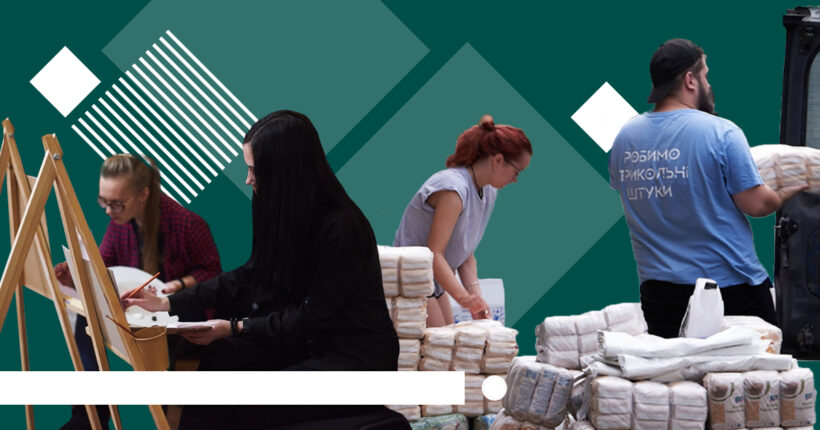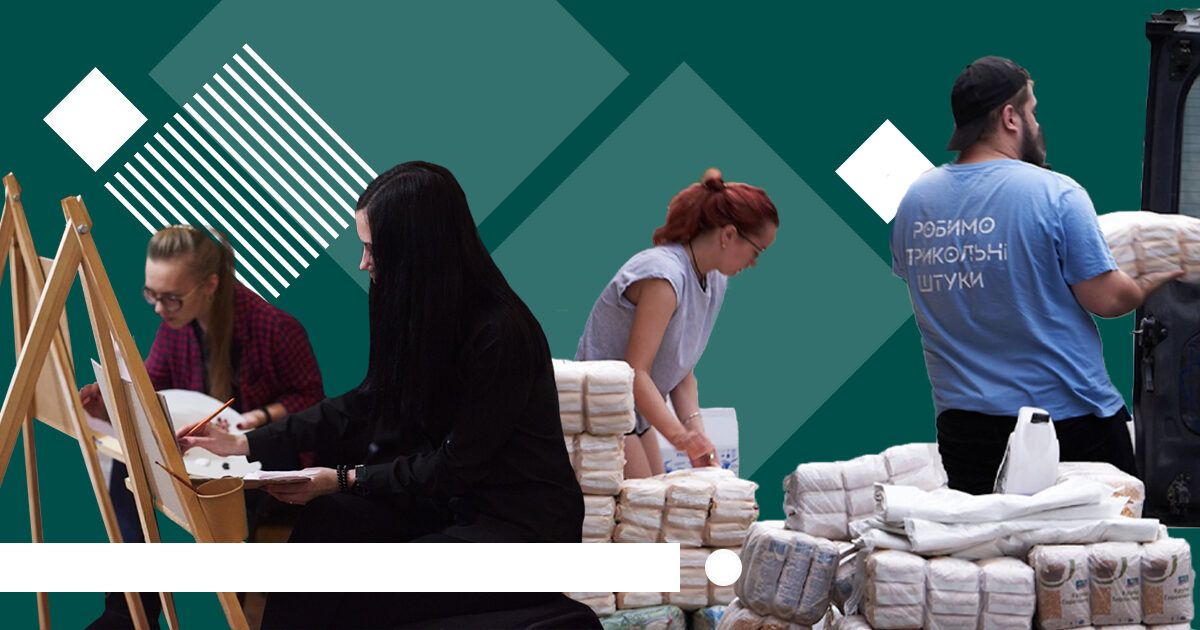
What is the problem?
Saving culture of destroyed cities
Public attitudes changed when the war broke out in Ukraine's east in 2014. People wanted to experience their own culture, to separate it from the narratives imposed by russia. This became an impetus for developing a new culture of the region, the involvement of young people in international projects, and the creation of new solutions to strengthen the Ukrainian spirit and unity.
At that time, the Ukrainian east began to develop in a new way. Attention to the cultural ecosystem of the Donetsk and Luhansk regions has increased. Among the projects created in this wave are the initiatives of the Shtuka public organization from the Donetsk region.

Source: NGO Shtuka
"We worked in different directions. These are art evenings and artistic meetings. We enabled artists to start doing their work, providing canvases and paints. There were also exhibitions about current regional problems—ecology, animal protection, society, and a project to combat the coronavirus. It was a public space in the city of Myrnohrad. We tried to develop cultural trends for our society, especially for young people," says Yevhen Brazhko, director of NGO Shtuka.
With the beginning of russia's full-scale invasion of Ukraine, the enemy began to mercilessly destroy the cities and towns of the east. Volnovakha, Mariupol, Popasna, Rubizhne, Sievierodonetsk, Lysychansk, and Bakhmut have already been partially or entirely destroyed, but russia continues to shell them. Thousands of people remain under constant fire in the frontline cities.
Local public organizations, which until February 24 were engaged in culture, ecology, or anything else, are now reformatting their work to help people. Thus, Shtuka faced the question: How to preserve the culture of cities where the enemy was turning into ruins? And, most importantly, how to help the carriers of this culture?
What is the solution?
Humanitarian and cultural aid
The Shtuka NGO's mission has always been to develop the cultural ecosystem of the Donetsk and Luhansk regions. Most of the projects until February 24 were aimed at developing cultural cooperation in the area, unification of community residents, and media education through videos, animations, pictures, and photos. After russia's full-scale invasion, Shtuka also focused its forces on providing humanitarian aid to the population of the east. At the same time, the team continues to develop the culture of its native regions, introducing new projects and programs.
Currently, 80% of Shtuka's work is collecting and delivering humanitarian aid (food, hygiene products, medicines, clothing, and energy carriers) to the communities of the Donetsk region. The team mainly works with Myrhorod and Pokrovsk.

Helping the military with uniforms. Source: NGO Shtuka
How does it work?
Lists of needs and help from partners
Humanitarian support to the communities of the Donetsk region, which host forcibly displaced persons and those suffering from hostilities, continues uninterrupted, starting from February 25.

Volunteers with humanitarian kits. Source: NGO Shtuka
"We started working almost from the first days [of the invasion]. People turned to us, saying they needed help, information, and advice on leaving. And we saw that the situation was worsening and that constant shelling continued. Therefore, immediate assistance became almost the most important direction, and currently, it takes up almost all of our time," explains Yevhen Brazhko.

Yevhen Brazhko. Source: Yevhen's FB page
Due to active hostilities, the team dispersed across the country but continues to work together. The process of collecting and delivering humanitarian aid is extensive and multi-step. First, the public organization receives lists from regions and cities of who needs assistance and what is needed. The lists are compiled by volunteer services and organizations working near combat zones. After that, the activists look for the necessary things — food, hygiene products, and clothes. Then all this is shipped and taken to the destination.
Due to significant needs, the team attracts donors and creates projects for international organizations financing aid to Ukrainians. For example, within the Volunteering During War program, activists were supported by House of Europe, ACTED, PIN, DRC, CORE, Renaissance, Nova Ukraine, DRA, Network 100% Life Charity Organization, FUNDACJA PROMOCJI NAUKI I KREATYWNOŚCI. The involvement of partners and donors continues to help better and do more.

Packing humanitarian aid. Source: NGO Shtuka
"We work with international and Ukrainian donors and purchase these products. That is, we are not raising donations. These are all grant funds. We use them to cover human needs in the Donetsk region. For example, there is the Myrnohrad humanitarian center. It is like a power structure that cooperates with international organizations and volunteers. We bring food kits, medicines, detergents, and hygiene products there. And so it happens with every city we visit. Basically, we do not give out aid. Instead, we pass it on to people through local volunteers," Maria Kutniakova, the communication manager of Shtuka NGO, explains the working principle.

Maria Kutniakova. Source: Maria's FB page
Hackathon, podcasts, films
At the same time, Shtutka is working on new projects about the Ukrainian East's culture and art. For example, the team started releasing the Nefiltrat podcast. This is a series of audio stories about activists and cultural artists who developed their cities before the war and continue to do so now. So far, they have recorded two episodes and are working on new ones.
Soon, the organization will present the Post-East 2.0 video project about the cities of the Donetsk region, the content for which was filmed before February 24. Last fall and winter, the team traveled around the area and filmed the industrialization of Donbas. There were meetings with locals, historians, and activists who talked about local architectural monuments.
As a result of russian aggression, most of the filmed monuments have already been destroyed. This made the project even more important. The filmed movies will show what Donetsk was like before russia's invasion, how it developed, how it lived, and what everyday problems it faced.
Currently, the Shtuka NGO is organizing a hackathon to generate ideas for integrating displaced people into local communities. The event will be held in January next year and will bring together teams to create new solutions. The three best ideas will receive certain funds for implementation.
Does it work?
From the beginning of April until the beginning of November, the Shtuka NGO delivered more than 5,400 food and 1,800 hygiene kits, about 200 pieces of clothing for displaced persons, various energy carriers for storage and utility facilities (3 EcoFlow charging stations, 23 generators, 400 candles, about 200 gas burners), as well as over-the-counter medicines to the communities of Donetsk and Luhansk regions. They could deliver aid to Sloviansk, Avdiivka, Maryinka, Vuhledar, Soledar, etc.

Source: NGO Shtuka
A total of 3.7 million hryvnias worth of humanitarian was distributed. The non-governmental organization continues to attract resources for humanitarian missions and helps the communities of the Donetsk region get through the brutal winter.
Now the organization plans to continue providing humanitarian aid to those in need. But they will also continue to hold cultural events aimed at the development of the culture of the Donetsk region and the support of its artists.





